Emotional Freedom Technique (EFT) – Part 2 – How to get started
The art and the science of tapping to release your sh*t
OK, maybe science isn’t quite the right word. For it to be scientific, we need to have a hypothesis, and then be able to test it. We do have a hypothesis, but there’s no way to test it.
What I WILL be covering in this post is:
• The hypothesis – how and why we think it works
• The method – the how-to-do-it of EFT
• The art – how to improve your results
This will make more sense if you’ve read my previous post.

This sounds loony – how can it possibly work?
I’m not sure whether this is originally Roger Callaghan’s theory or Gary Craig’s.
Roger Callaghan studied Traditional Chinese Medicine, which got him started experimenting with meridians. TCM has worked with these meridians for thousands of years, mostly using acupuncture needles to stimulate (or relax) energy flows in the meridians. Natural therapies such as acupressure and Applied Kinesiology also work with the meridians.
More recently, western science has been starting to identify these energy pathways in the body. Some describe them as the Primo Vascular system. Reference
The theory with EFT is that when we have any kind of trauma or upset, this creates a disturbance in the meridians. When we think about the incident, it activates the disturbance, and we experience what we would think of as a negative emotion. It is this disturbance that causes the emotion, or at least causes it to be more intense, or to get stuck.
When we tap on the ends of the meridians, while thinking of the upsetting incident, the disturbance in the meridian is removed, and the associated emotion goes away or reduces.
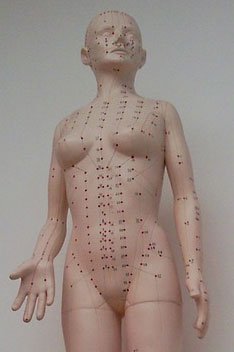
That is the current best guess of why it works. Some may say it’s because talking about the event helps. While that may be true, people seem to get better results than just seeing a therapist.
So now you may say it’s the placebo effect. I don’t think it is, because I’ve had success with people who didn’t believe in it. And occasionally a lack of success with people who did believe. When it doesn’t work, sometimes it’s because a different therapy is needed, maybe something more physical like changing diet or getting some exercise.
But, yes, it still could be a placebo. So I ask you – what if it is? Does that make it invalid? I don’t believe so, because we know how powerful the placebo effect is. If we can sit in our own homes, tapping on ourselves and activate our own placebo response, that’s still pretty awesome.
On my last EFT post, @honeyscribe mentioned that she’d had good results from being tapped on, but not from tapping herself. So before we move on, I’ll mention a hypothesis about that.
The usual theory is that, when two people are working together, the combined focus on an issue creates a synergy that helps it move faster. This seems to occur when 2 people sit facing each other and each tap on themselves for the client’s issue. It may be synergy, but it may also be simply that an outside person has a different view of what may have been going on. As the emotional intensity goes down, this is often able to be gently introduced as a possible new angle.
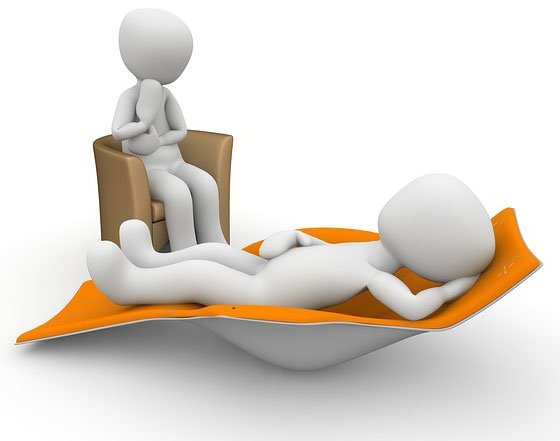
When the therapist taps on the client, a whole new level is introduced. I think it’s because the client is able to fully relax and get in tune with the issue, thereby allowing it to shift more quickly.
The method
The original “recipe” Gary devised involved four steps – the set up, once through the meridians, the 9 gamut, second time through the meridian points. Over time, that has become simplified to the shortcut method – the set up, plus once through half of the meridian points. So that’s all we’re going to cover today.
Before we start tapping, we need to decide what to tap about. If you’re feeling a strong emotion already, that’s where you’ll start. So identify the emotion (for the example, let’s choose anger) and rate its intensity. 10 is the worst you’ve ever experienced, 0 is non-existent.
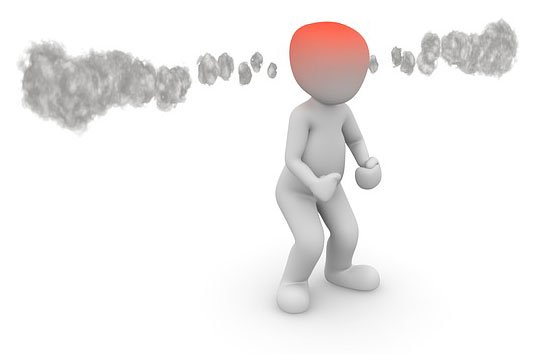
The set up
For this step, we tap on what’s known as the karate chop point. This located on the side of the hand, just down from the little finger. (see the picture below)
While tapping, we might say “Even though I am angry, I fully and deeply accept myself”. So we’re identifying the upset we want to clear, and stating that despite that, we are absolutely fine. The issue is not who we are, it’s just something we happen to be experiencing right now.
You can go into more depth eg I’m angry with Mr X, or I’m angry about the ABC that happened.
You can also choose a different self acceptance phrase eg I love and forgive myself, or for children, I’m a cool kid.
Repeat this phrase three times, while tapping on the karate chop (KC) point with the flat of your other hand.
Going through the meridian points
At each point, tap gently about 8-9 times, or as long as it takes to say your reminder phrase. The reminder phrase is to keep you tuned into the upset you identified, and in our example is “this anger” or “this anger with X” or “this anger about ABC”.
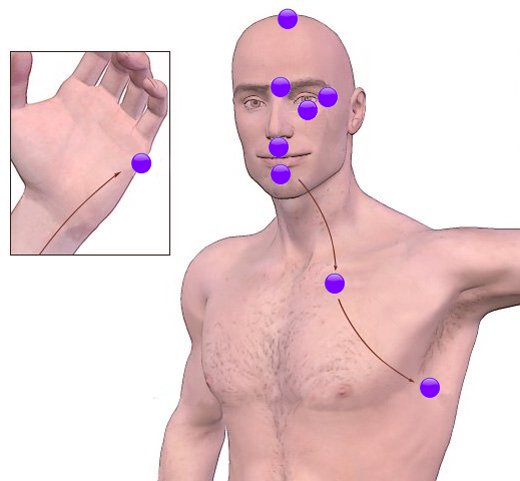
• Top of the head
• EB = Beginning of the Eye Brow
• SE = Side of the Eye, on the bone bordering the outside corner of the eye
• UE = Under the Eye, on the bone under the eye, directly below your pupil
• UN = Under the Nose, between the bottom of your nose and your upper lip
• Ch = Chin, between the point of your chin and the bottom of your lower lip, on the crease, sometimes called the lower lip point
• CB = Beginning of the Collar Bone. Put a finger on the tip of one collarbone. Move out about a cm and down about a cm. This will be a point nestled under the tip of the collarbone. This is the exact spot. But tapping on the tip of the collarbone is easier and accurate enough.
• UA = Under the Arm. On the side of the body, about 4” below the armpit, at a point even with the nipple (men) or in the middle of the bra strap (women).
Most of the points you will tap with 2 finger tips, though the underarm point is easier done with the flat of the hand.
Re-evaluating
Take a deep breath in and then let it out. Close your eyes and revisit the feeling. What intensity is it now? Is it still the same feeling? Are there any new thoughts and feelings coming up?
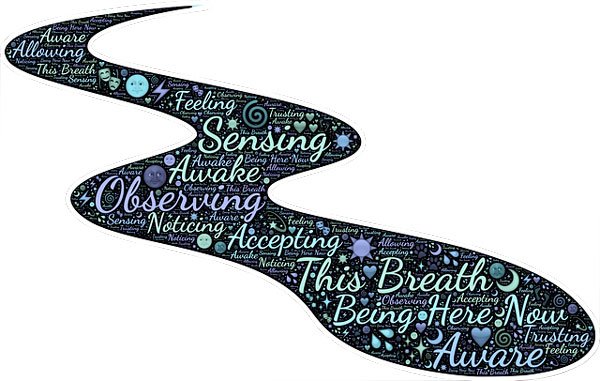
If the feeling has lessened, but is still there, do another round. This time your phrases will be “Even though I still have some anger, I fully and deeply accept myself” and “remaining anger”.
If the feeling is stronger than before, it means you got more in touch with it. So that’s ok too. Do another round, as above.
If the feeling has gone, move on to whatever new feelings or thoughts have come up.
It’s important to be thorough. When you think you’re done, test. Can you think about the situation in detail – the sights, the sounds, the emotions – and still feel fine? If not, there’s more work to be done.
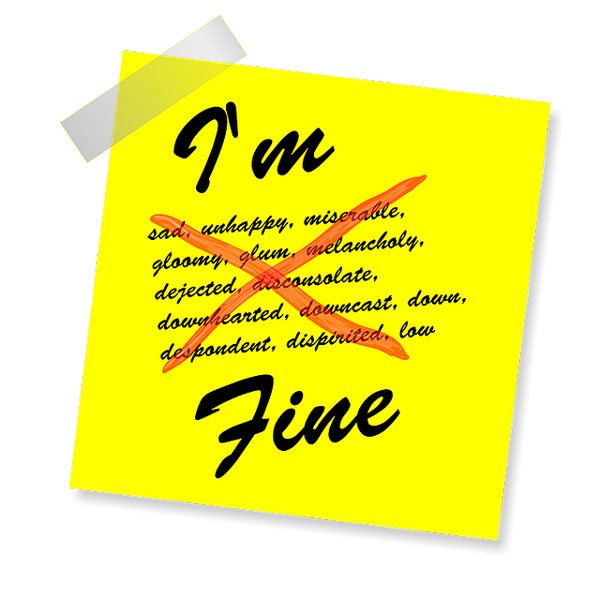
The art of tapping
This is already a long post, so I won’t go on to much about this. Simply put, the art is knowing what to tap about, or knowing what to say.
When I sit opposite a client, leading them in what to say, many times I’ve heard “How did you know? That was exactly right!” I usually say “It just comes to me” but the long answer would be: one part listening skills, one part empathy, and one part being open to whatever idea pops into my head. It’s very rarely wrong. This is part of the art of tapping; being in tune with the client.
Another part of it is being a good detective – ask questions, follow hunches, keep getting feedback.

Sometimes you need to approach an issue from different angles. For example, if you want to stop smoking. The first approach might be to use it as first aid, when the cravings are hitting you hard. This will usually stop the cravings, for now… You can tap every time you have a craving and eventually it will lessen, but you still need to go deeper usually.
Next you might start tapping about the habit – thinking of all the times when you habitually smoke. Lastly, you might think about what emotions or events you are suppressing when you smoke, and address those.
If you’re tapping for yourself, it’s not quite so easy, but see if you can listen to your own self talk. This is usually a big indicator of what could be cleared.
Really think about what you’re feeling. Is it anger, annoyance, fury? Be specific.
For more information
• Visit my website for more information and examples of you to address different issues
• Visit Gary Craig’s official EFT website to get more information from the founder of EFT
Important parting notes
Remember that what I’m telling you about here is my own experiences. It does not constitute medical advice.
If you feel like having a go, start with day to day incidents.
But there is one thing you need to be careful of. Gary calls it “not going where you don’t belong”. What he means is, don’t go into the deep and nasty stuff on your own. If you have trauma, see a specialist who can support you if needed.
This is intended to be a gentle technique. You need to get in touch with the emotion to be able to clear it, but don’t go in so deep that you’re re-traumatising yourself.
In the end, only you can know what is right for yourself and your family, so do (or don’t do) whatever you need to keep yourselves safe.
Thanks for reading
Follow me for more health, nutrition, food, lifestyle and recipe posts.
I am now on Peerhub offering one on one nutritional coaching and EFT (Emotional Freedom Technique) sessions by Skype.
Some of my previous posts:
THOUGHTS ABOUT LIFE: My Intro ~ Are there kiwis in the house? ~ Benefits of joining a community choir ~ My grandmother’s legacy ~ Steemit in downtown Wellington ~ Overcoming my fears ~ Observations from a bus ~ The brandy snap maker ~ Wearable Arts Award Show ~ 2 months on Steemit and now curating health, nutrition and recipes ~ Positivity Challenge 3 – Acts of kindness ~ Positivity Challenge 4 with a twist ~ Positivity Challenge 4 – Emotional Freedom Technique Part 1
HEALTH AND NUTRITION: The wide variety of healthy diets out and what they have in common ~ The travels of Weston A Price and his discoveries about healthy diets ~ Good fats vs bad fats ~ DNA testing for better Health & Fitness ~ DNA testing part 2: How Well Do I Digest Carbs? ~ DNA testing Part 3: I can’t eat Carbs & How to Manage that ~ About the Gut & Psychology syndrome (GAPS) diet Part 1 ~ GAPS diet Part 2: Foods we can’t have ~ GAPS diet Part 3: Foods we CAN have ~ GAPS diet Part 4: What if I can’t eat some animal foods ~ Salicylate intolerances ~ Thoughts about Breast Health ~ I’ve got a cold & how to handle it ~ Sleep like a kitten Part 1 – 3 tips ~ Sleep Well Part 2 – What’s your sleeping style? ~ Sleep Well Part 3 – Resetting your body clock



I have used this technique for over ten years and think it is superb. I don't care why it works it certainlly helps my agoraphobia!
Nice to hear that it's helped you. I don't really care why either, but for some people that's important.